The Soldier's Details

- Surname:
- Armstrong
- First Name:
- Malcolm
- Nick Name:
- Lofty
- Rank:
- Corporal (Promoted 11.2.1942)
- Regimental #:
- WX7046
- Company:
- ‘A’ Company, 4 Platoon.
- Enlisted:
- 30.07.1940
- Discharged:
- 25.05.1946
- DOB:
- 1.09.1915
- Place of Birth:
- South Perth, Western Australia
- Father's Name:
- Not Known
- Mothers's Name:
- Lillian Armstrong
- Religion:
- Miner
- Pre-war Occupation:
- Miner
- Singapore:
- Selarang Camp Changi
- Force:
- 'A' Force Burma, Green Force, No. 3 Battalion
- Camps Thailand:
- Tamarkan, Tamuang, Bangkok, Ubon
- Camps Burma:
- Victoria Point, Kendau 4.8km, Thetkaw 14km, Meiloe 75km, Aungganaung 105km, Khonkan 55km (evacuated sick from 105km Camp on 1.7.1943)
- POW#:
- 1373
- Return Details 1945:
- Thailand-Singapore by aircraft, Singapore-Fremantle, HMT Moreton Bay
General Description
Armstrong was wounded in action at Buona Vista on 15/2/1942. Admitted to 2/13th Australian General Hospital with a shrapnel would to his right shoulder. Discharged to unit on 24/2/1942.
Lofty was appointed 2 I/C of ‘A’ Company 2/4th MG Btn on the appointment of Major Saggers to Special Reserve Battalion.
Please read about men of A Company No. 4 Platoon
He was selected as a PoW in Singapore to work on Burma end of Burma-Thai Railway with ‘A’ Force Burma, Green Force No. 3 Battalion which sailed from Singapore 14 May 1942 for south west coast of Burma. The 3,000 strong force would repair and enlarge 3 airfields at Victoria Point, Tavoy and Ye before heading to the railway.
Lofty was with Green Force and first worked at Victoria Point before making their way to the northern most point of the Rail link to commence work on 1 October 1942 at Kendau 4.8km Camp – the first Australians to Work on Burma-Thai Railway.
Please read further about this Battalion
Also please read about Khonkan 55km Hospital Camp
And Albert Coates and Claude Anderson
When the railway was completed by end of 1943, the Japanese began moving all POWs in Burma south into Thailand into one of several large camps. Lofty was sent to Tamarkan – possibly sick, before being sent to Tamuang. He was not selected as ‘fit’ by Japanese to work in Japan – sailing with ‘Rakuyo Maru’ Party (which sank in South China Sea having been torpedoed by American submarines in Sept 1944).
Lofty was recovered Ubon when the war finished.
He was discharged May 1946 and returned to Mt. Magnet.
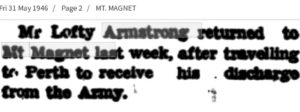
__________
Lofty enlisted with AIF 30 July 1940 later joining 2/4th MGB. He had previously been working as a miner at Mt Magnet and here he met his future wife. Gold had been discovered at Mt Magnet in 1891 and a townsite gazetted in 1895. The railway to Mt. Magnet was completed in 1897 and opened July 1898 (closing in 1978).
In November 1940 he married Edna May Osmond of Mt. Magnet, her parents John James Osmond and Elsie Willis married about 1918. She had one brother John, both children attended the local school. The Osmond family had been in Mt Magnet since the arrival of Edna’s grandparents in early 1900. Edna’s parents were very active Mt Magnet community members. Sports, hospital boards, etc.
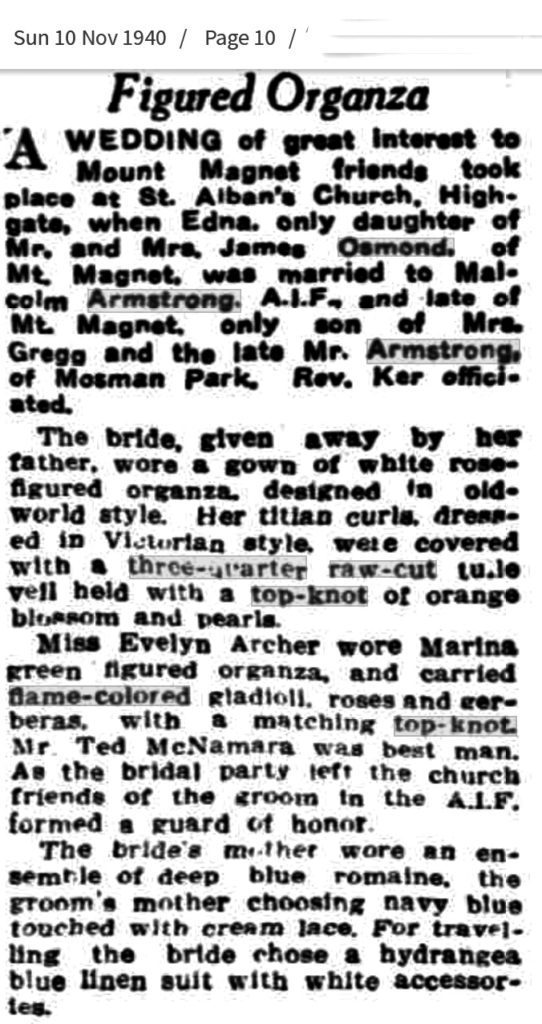
Below: Edna’s grandfather William James Willis died 1942 at Mt. Magnet.
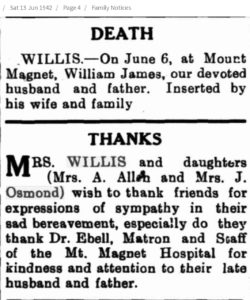
Lofty, Edna and family resided 14 Forward Road, Manning for much of their lives. Lofty worked as a sheetmetal worker. We know they had a daughter who was born at Mt Magnet 1947 and at least one son, John James Armstrong.
Lofty passed away on 7th March 1990 and was buried at Karrakatta Cemetery. He was 74 years old. Edna died 6 March 2006 aged 90 years.
Regretfully, our research has returned very little of Lofty’s childhood. His mother Lillian Armstrong married 1924 to Samuel Gregg. It is believed she died 1966.
Please read about 2/4th boys from Albany region.
__________________
Grandfather of Enda died in 1911. He had lived in Mt. Magnet for at least the last decade.
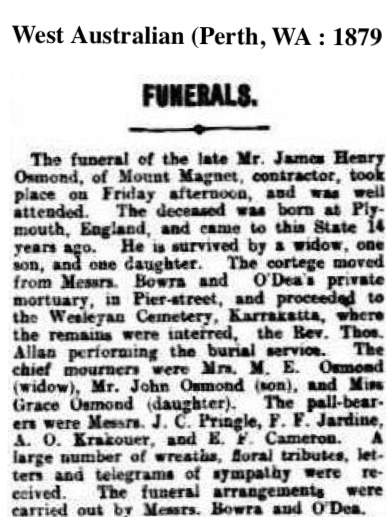
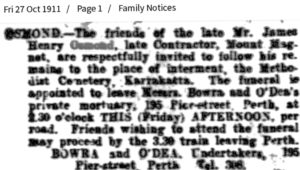
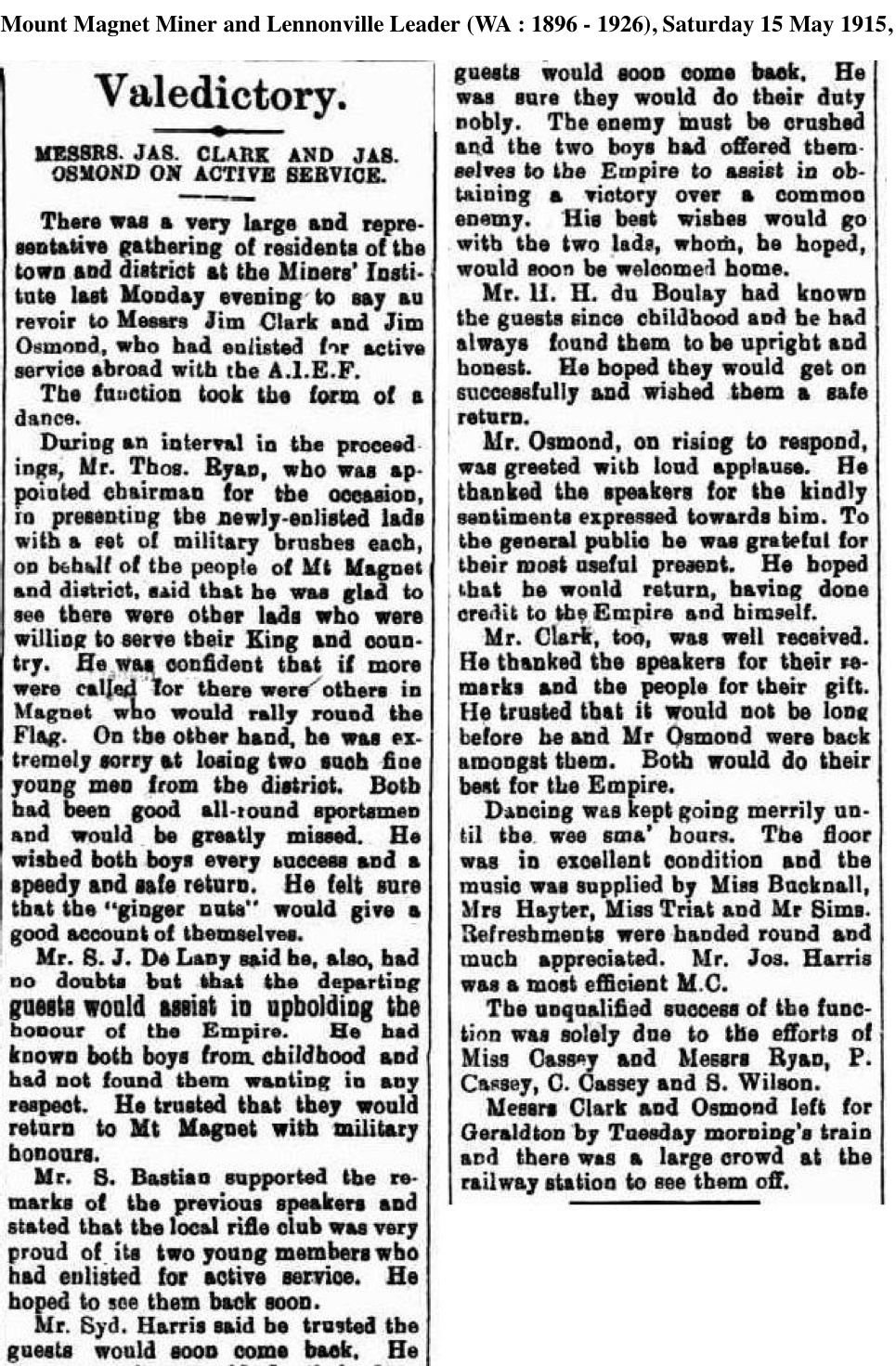
Edna’s father John James Thomas Osmond, enlisted WW1 on 7 June1915 at Geraldton aged 25 years. NOK was his mother Mary Osborn. Service No. 2303, Osmond joined 8/11th Reinforcements and was sent to Gallipoli, received GSW to finger. He later was transferred to 16th Btn and on 11 April 1917 during fighting at Bullecourt, France was reported Missing in Action later found to be Prisoner of War (1170 Australians were captured Bullecourt). He had received GSW to his jaw and was interned Munster, Germany. He was later transferred to Switzerland on 27 Dec 1917. Osmond finally arrived London 6 March 1918.
The following information is from Anzac Portal:
https://anzacportal.dva.gov.au/wars-and-missions/ww1/personnel/australian-pows#2
‘Towards the end of the war, POWs began to be assessed by neutral Swiss medical commissioners. Some long-term prisoners, mostly officers and non-commissioned officers, who were sick, seriously wounded or suffering from psychological conditions became eligible for internment in Switzerland and The Netherlands.’
Read further ***
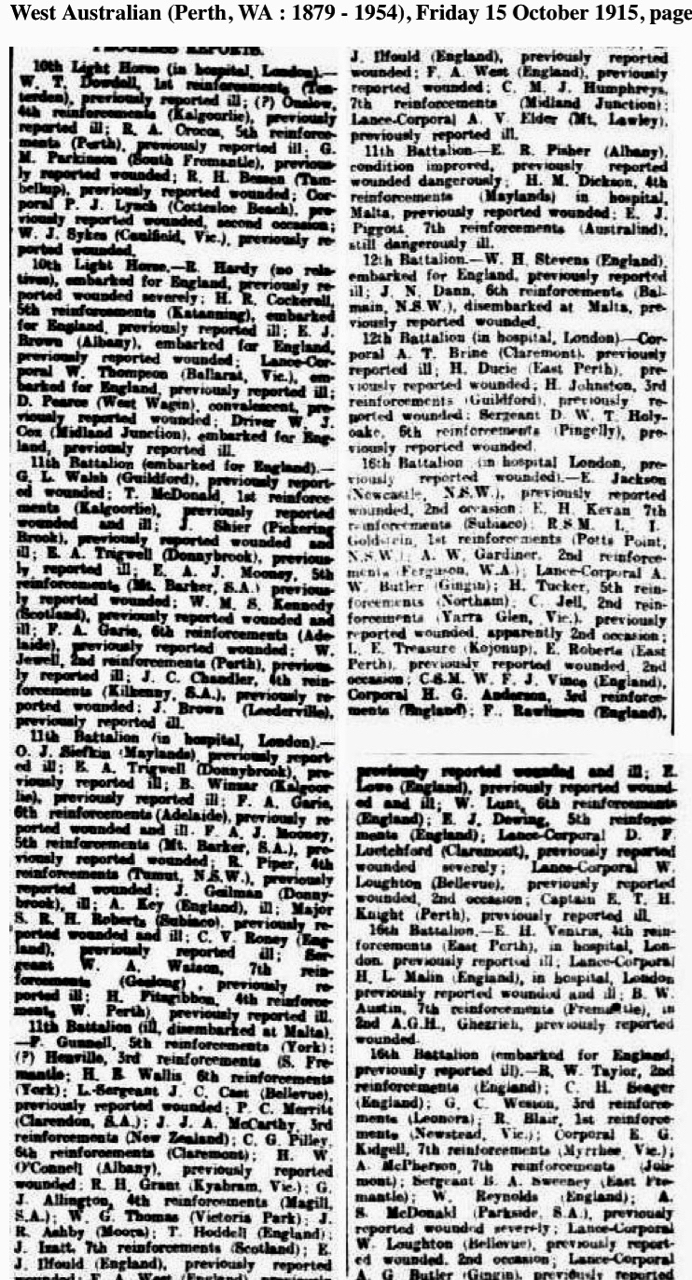
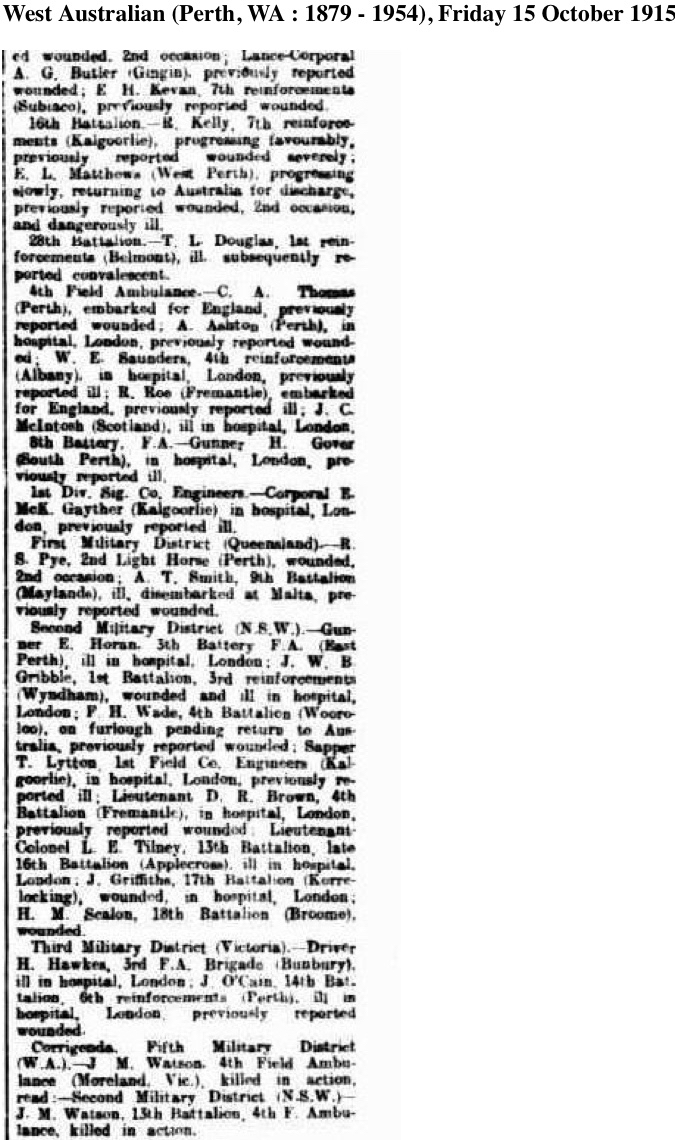

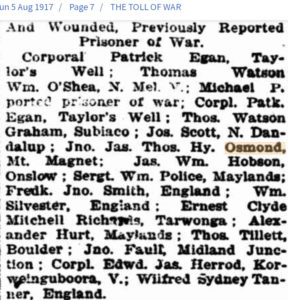
After the war ended, life seemed happy for the Osmond family at Mt Magnet – Their son John (Bluey) who had joined the RAAF returned home safely and their son-in-law, Lofty Armstrong survived being a POW of Japan.
John Osmond was decorated. Tragedy struck when he was killed in a traffic accident Jan 1946 he was on 23 years only. It seems unfair – he survived all those missions over war-torn Europe and returned home.

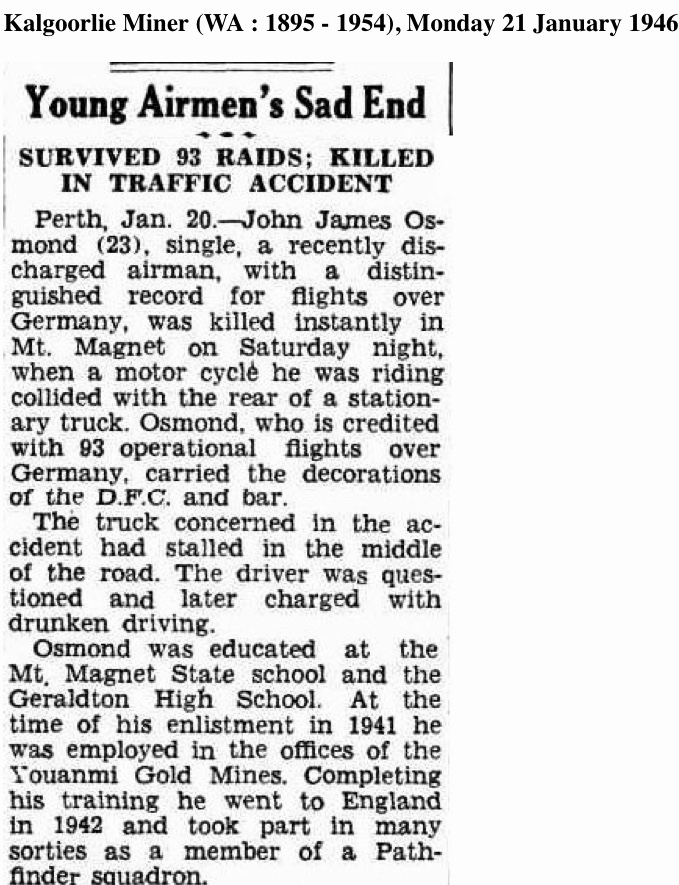
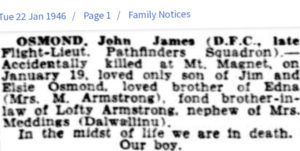
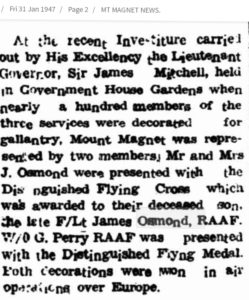
John Osmond was buried at Mt Magnet Cemetery.
_________
***.
The International Committee of the Red Cross (ICRC) and Swiss Government put forward a suggestion to Germany, France, Britain, Russia and Belgium regarding POWs. In 1915 they confirmed an agreement stating captured military and naval personnel who were too seriously wounded or sick to be able to continue in military service could be repatriated through Switzerland, with the assistance of the Swiss Red Cross.
Travelling Swiss doctors visited PoW camps to select potential internees. Once selected the POW would be brought before a board comprising two Swiss Army doctors, two doctors from the country holding him captive, and a representative of the prisoner’s own nation. If illness/injury permitted, POWs were expected to work. This could be farm labouring, working for a private Swiss firm the POW’s pre-war profession or even learning a new trade which would be useful after the war.
Internees were held or worked at a number of locations. British POWs (and one believes this includes Commonwealth personnel) were located in camps in south-western Switzerland, east of Lake Geneva.
In 1917 this agreement was extended to include those POWs who were suffering from ‘barbed-wire’ syndrome and susceptible to mental illness.
There were no Russian POWs sent to Switzerland.
Camp Locations:
- Selarang Camp Changi - Singapore
- Tamarkan, Tha Makham 56k - Thailand
- Tamuang, Tha Muang 39k - Thailand
- Ubon - Thailand ***
- Aungganaung,105Kilo - Burma
- Kendau, Kandaw, 4 Kilo - Burma
- Khonkan, 55Kilo Hospital 360k - Burma
- Meilo, 75 Kilo, 340k - Burma
- Victoria Point, Kawthoung - Burma. \'A\' Force, Green Force No. 3 Btn
- Thetkaw 14 Kilo - Burma






